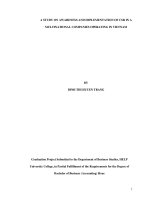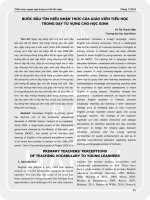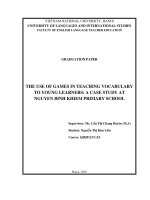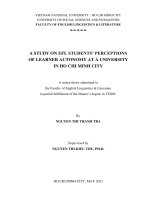A study on efl teachers’ perceptions of the use of quizlet in teaching vocabulary to young learners at an english center
Bạn đang xem bản rút gọn của tài liệu. Xem và tải ngay bản đầy đủ của tài liệu tại đây (894.39 KB, 89 trang )
MINISTRY OF EDUCATION AND TRAINING
QUY NHON UNIVERSITY
PHAN MỸ LINH
A STUDY ON EFL TEACHERS’ PERCEPTIONS OF THE
USE OF QUIZLET IN TEACHING VOCABULARY TO
YOUNG LEARNERS AT AN ENGLISH CENTER
Field: Theory and Methodology of English Language Teaching
Code: 8140111
Supervisor: TRUONG VAN DINH, Ph.D.
Binh Dinh - 2023
BỘ GIÁO DỤC VÀ ĐÀO TẠO
TRƯỜNG ĐẠI HỌC QUY NHƠN
PHAN MỸ LINH
NHẬN THỨC CỦA GIÁO VIÊN TIẾNG ANH VỀ VIỆC
SỬ DỤNG QUIZLET ĐỂ DẠY TỪ VỰNG CHO TRẺ EM
Ở TRUNG TÂM ANH NGỮ
Ngành: Lý luận và phương pháp dạy học bộ môn Tiếng Anh
Mã số: 8140111
Người hướng dẫn: TS. TRƯƠNG VĂN ĐỊNH
Bình Định - 2023
i
STATEMENT OF AUTHORSHIP
The thesis entitled “A study on EFL teachers’ perceptions of the use of
Quizlet in teaching vocabulary to young learners at an English center” is
conducted under the direction of Truong Van Dinh, Ph.D. at Quy Nhon
University.
I declare that the information reported in this study is the result of my
own work and effort, except where due reference is made. This thesis has not
been submitted to any university for the award of a degree.
Binh Dinh, 2023
PHAN MY LINH
ii
ACKNOWLEDGEMENTS
The total completion of this scientific research project is the result of
not only my efforts but also the precious assistance of those to whom I would
like to express my sincere gratitude.
First of all, I am really grateful to my supervisor, Dr. Truong Van Dinh,
for her great instruction, encouragement, patience, and vital assistance. He has
always been available to support me not only academically but also
spiritually.
Secondly, I would like to thank the primary teachers and English center
teachers who participated in this study for their willingness to contribute
useful thoughts and experiences about teaching English to young learners
through questionnaires and interviews.
Thirdly, my heartfelt thanks also go to the Department of English
teachers for the invaluable knowledge they shared with me during my M.A.
program. I would also like to thank all of the librarians at Quy Nhon
University for allowing me to find and borrow valuable documents.
Furthermore, my greatest gratitude is also sent to my loving family,
which includes my parents, younger sister, and older brother. I dedicate this
thesis to my family because of their constant support and unconditional love.
Their love drives me to finish this degree.
Finally, I would like to show my gratitude and blessings to everyone
who assisted me in completing my thesis.
iii
ABSTRACT
Vocabulary is at the heart of developing proficiency and achieving
competency in any language learning skill. Moreover, as technology
advances, the process of incorporating technology with education has become
increasingly necessary. Therefore, this study aimed to explore teachers’
perceptions of using Quizlet to teach vocabulary to young learners. This study
used a descriptive quantitative and qualitative approach, collecting data via
questionnaires and interviews. The research was conducted at an English
center in Gia Lai Province with the participation of 17 EFL teachers. The
findings of the study revealed that the majority of teachers had positive
attitudes of using Quizlet in teaching vocabulary to young learners. The
teachers said that using Quizlet helped their students acquire new vocabulary
quickly, remember vocabulary longer and draw young learners’ greater
attention. However, there are also some difficulties that EFL teachers face
with Quizlet such as limited time, controlling classrooms, Internet connection.
The researcher suggests that further studies in this area should consider a
bigger sample size as well as use a variety of instruments to get a deeper
understanding of EFL teachers’ perceptions of teaching vocabulary with
Quizlet.
iv
TABLE OF CONTENTS
STATEMENT OF AUTHORSHIP............................................................. i
ACKNOWLEDGEMENTS ........................................................................ ii
ABSTRACT ................................................................................................. iii
TABLE OF CONTENTS ........................................................................... iv
LIST OF ABBREVIATIONS .................................................................viii
LIST OF TABLES ...................................................................................... ix
CHAPTER 1: INTRODUCTION .............................................................. 1
1.1. Rationale ............................................................................................ 1
1.2. Aim and Objectives of the Study..................................................... 2
1.2.1. Aim of the Study ............................................................................ 2
1.2.2. Objectives of the Study .................................................................. 2
1.3. Research Questions........................................................................... 3
1.4. Scope of the Study............................................................................. 3
1.5. Significance of the Study .................................................................. 3
1.6. Organization of the Study ................................................................ 4
CHAPTER 2: LITERATURE REVIEW .................................................. 6
2.1. Vocabulary ........................................................................................ 6
2.1.1. Definition of Vocabulary...............................................................6
2.1.2. Importance of Vocabulary ............................................................ 6
2.1.3. Types of Vocabulary ...................................................................... 9
v
2.1.4. Vocabulary Teaching and Learning ............................................. 9
2.1.5. Teaching vocabulary to young learners ..................................... 11
2.2. Young Learners .............................................................................. 12
2.2.1. Definition of Young Learner.......................................................12
2.2.2. Characteristics of Young Learners ............................................. 13
2.2.2.1. Intellectual development ...................................................... 12
2.2.2.2. Attention span ...................................................................... 13
2.2.2.3. Sensory input........................................................................ 13
2.2.2.4. Affective factors ................................................................... 14
2.2.2.5. Authentic, meaningful language ......................................... 14
2.3. Quizlet .............................................................................................. 15
2.3.1. Definition of Quizlet.................................................................... 15
2.3.2. Application of Quizlet to Teaching and Learning Vocabulary..16
2.3.3. Benefits of Quizlet in Teaching and Learning Vocabulary ....... 18
2.3.4. Use of Quizlet .............................................................................. 19
2.4. Teachers’ perceptions ....................................................................... 19
2.4.1. Definition of teachers’ perceptions ............................................ 19
2.4.2. Types of Perception ..................................................................... 20
2.5. Previous Studies .............................................................................. 20
2.6. Summary ......................................................................................... 24
CHAPTER 3: RESEARCH METHODOLOGY .................................... 25
3.1. Research Design .............................................................................. 25
vi
3.2. Research Setting.............................................................................. 26
3.3. Participants ..................................................................................... 26
3.4. Materials .......................................................................................... 28
3.5. Research Instruments..................................................................... 29
3.5.1. Questionnaire .............................................................................. 29
3.5.2. Interview ...................................................................................... 30
3.5.3. Data Analysis...............................................................................31
3.6. Summary ............................................. Error! Bookmark not defined.
CHAPTER 4: FINDINGS AND DISCUSSION...................................... 33
4.1. Findings from Questionnaire ......................................................... 33
4.1.1. EFL Teachers’ Perceptions of Importance and Necessity of
Quizlet .......................................................................................... 34
4.1.2. EFL Teachers’ Perceptions of Benefits of Quizlet.....................36
4.1.3. EFL Teacher’s Perceptions of Disadvantages of Quizlet..........39
4.2. Findings from Interview ................................................................. 38
4.2.1. A Useful App for EFL Teachers’ Vocabulary
Teaching.....................................................................................39
4.2.2. Least Useful Aspects of Quizlet in Teaching ...........................40
4.2.3. Some Useful Aspects of Quizlet in Teaching
Vocabulary...........................................................................................44
4.2.4. EFL Teachers’ Difficulties in Using Quizlet to Teach
Vocabulary...........................................................................................45
4.2.5. EFL Teachers’ Suggestions for Using Quizlet more
vii
Effectively.............................................................................................46
4.2.6. EFL Teachers’ Future Intentions of Teaching Vocabulary with
Quizlet...................................................................................................47
4.3. Summary ......................................................................................... 47
CHAPTER 5: CONCLUSION................................................................. 49
5.1. Conclusion ....................................................................................... 49
5.2. Implications of the Study ............................................................... 51
5.3. Limitations of the Study and Suggestions for Further Research
.......................................................................................................... 48
5.3.1. Limitations of the Study ............................................................. 48
5.2.2. Suggestions for Further Research ............................................. 49
REFERENCES........................................................................................... 53
APPENDICES
viii
LIST OF ABBREVIATIONS
A Agree
App Application
D Disagree
EFL English as a Foreign Language
ICT Information and Communication Technology
MALL Mobile-assisted Language Learning
PC Personal Computer
R Researcher
SA Strongly Agree
SD Strongly Disagree
T Teacher
U Unsure
YL Young Learner
ix
LIST OF TABLES
Table 2.1: Quizlet learning modes on website and mobile app ...................... 16
Table 3.1: Participants’ background characteristics (Valizadeh, 2021) ......... 27
Table 3.2: Description of the items used for the survey ................................. 30
Table 4.1: EFL Teachers’ perceptions of importance and necessity of Quizlet
......................................................................................................................... 34
Table 4.2: EFL Teachers’ perceptions of benefits of Quizlet ......................... 34
Table 4.3: EFL Teachers’ perceptions of disadvantages of Quizlet ............... 40
1
CHAPTER 1: INTRODUCTION
Chapter 1 introduces the rationale underlying this current study. The
chapter is divided into six main parts: Rationale, Aim and Objectives,
Research Questions, Scope, Significance and Organization of the Study.
1.1. Rationale
English, an international language used by many people all over the
world, is the target language taught in most schools in Vietnam and is used to
communicate across nations either orally or in writing. It is also regarded as
one of the world's required languages and is critical to master, particularly for
young students. Moreover, English is one of the compulsory subjects at
almost schools across Vietnam. Therefore, more and more Vietnamese people
are spend much time studying English as a second language.
Speaking, listening, reading, and writing are the four language skills that
English teaching aims to help students acquire. Learning language elements,
such as pronunciation, grammar, spelling, and vocabulary, is important to
assist the development of the four language skills. Among them, vocabulary is
thought to be one of the language components that contribute significantly to
the development of language skills. Schmitt and McCarthy (1983) believes
that in order to grasp a language, students must memorize thousands of words.
Indeed, vocabulary is core component of any foreign languages, and English
is no exception.
Whether learners are adults or young children, it is important for them to
expand their vocabulary. This is because a lack of vocabulary can become a
long-term trouble. Therefore, learners should find out the suitable ways to
learn vocabulary as soon as possible since their brain is ready for learning and
2
most of them have abilities to memorize well from a very early age. Hence,
teaching or learning vocabulary is always a problem which attracts learners’
attention these days. In other words, a lot of teachers are concerned about how
to teach vocabulary to their students effectively. Schmitt and McCarthy
(1997) suggest the following methods for learning vocabulary: (1) guessing
from context, (2) using words parts and mnemonic techniques to remember
words, and (3) using vocabulary cards to remember foreign language-first
language word pairs. With these methods, students need to take much time to
learn by heart new words, which makes them feel bored, especially to young
learners. Moreover, it is difficult for learners to use the vocabulary in
communication.
Fortunately, we are living in the 21st century with the development of
technology at an alarming rate. There is a great variety of applications which
were appeared, especially Quizlet. Quizlet is a useful app that combining
colorful pictures, words and even sounds, which makes students increase their
motivation of learning vocabulary and help them learn a lot of vocabulary in
short time. Furthermore, the issue is that few studies were carried out on the
fields of using Quizlet to teach and learn vocabulary to young learners in
Vietnam. Based on all the reasons above, the researcher has made a decision to
conduct the study entiled “EFL teachers’ perceptions of the use of Quizlet in
teaching vocabulary to young learners at an English center.”
1.2. Aim and Objectives of the Study
1.2.1. Aim of the Study
This study aims to find out about EFL teachers’ perceptions of the use
of Quizlet in teaching vocabulary to young learners with a view to helping
them to improve the effectiveness of teaching vocabulary to this type of
learners with Quizlet.
3
1.2.2. Objectives of the Study
In order to achieve the aims, the objectives of the study are:
+ To find out about the challenges EFL teachers face of teaching
vocabulary to young learners with Quizlet.
+ To investigate EFL teachers’ perceptions of teaching vocabulary to
young learners with Quizlet.
1.3. Research Questions
To accomplish the aim and the objectives, the study seeks to answer the
following research questions:
1. What challenges do EFL teachers face in teaching English
vocabulary to young learners with Quizlet?
2. What are EFL teachers’ perceptions of teaching vocabulary to young
learners with Quizlet?
1.4. Scope of the Study
This study is only carried out in the academic year 2022–2023. Because
of limited time, competence as well as research conditions, the scope of the
study is only limited to 17 teachers at an English center in Gia Lai Province.
Participants’ background characteristics are presented as indicated in Table
3.1. In addition, this study concentrates only on two aspects: teachers’
perceptions of teaching vocabulary with Quizlet to YLs and the challenges
that EFL teachers face when utilizing Quizlet to teach vocabulary to YLs.
1.5. Significance of the Study
Theoretically, the study not only provides some insight into EFL
teachers’ perceptions and their practice of teaching vocabulary to YLs but
also suggests some approaches to the challenges posed by the teaching of the
4
vocabulary to learners of different ages.
Practically, it is hoped that the research will bring a variety of benefits
for teachers, YLs and researchers. For teachers, they could have a deeper
understanding about the effectiveness of using Quizlet and they have more
opportunities to learn about how to apply Quizlet in classrooms effectively.
For YLs, hopefully, this study can help them raise the awareness of the
importance of learning vocabulary so that they are able to find out suitable
methods themselves at an early age. Also, the study can make a contribution
as a source of references for other researchers in conducting further research.
1.6. Organization of the Study
The research is divided into 5 chapters: Introduction, Literature
Review, Research Methodology, Findings and Discussion and Conclusions
and Recommendations.
Chapter 1, Introduction, provides the rationale, aim and objectives,
research questions, scope, significance and organization of the study.
Chapter 2, Literature Review, gives definition of vocabulary,
importance of vocabulary, vocabulary teaching and learning, definition of
young learners, characteristics of young learners, definition of Quizlet,
application of Quizlet in teaching and learning vocabulary, benefits of Quizlet
in teaching and learning vocabulary, use of Quizlet and previous studies
related to the topic of the present study.
Chapter 3, Research Methodology, presents the research methods of the
study, data collection and data analysis.
Chapter 4, Findings and Discussion, explains the results gained in the
processing of the data and discusses the results of the data analysis.
Chapter 5, Conclusion, presents the research findings, limitations and
5
makes some suggestions for further study.
6
CHAPTER 2: LITERATURE REVIEW
The purpose of Chapter 2 is to develop the study's theoretical
framework. It examines the literature on vocabulary knowledge and its
importance in language acquisition, and the application of Quizlet aided
vocabulary teaching and learning. Besides, this chapter also reviews some
related studies on Quizlet in teaching and learning vocabulary in Vietnam and
all over the world.
2.1. Vocabulary
2.1.1. Definition of Vocabulary
There are lots of definitions for the term “vocabulary”. According to
Richard (2001), one of the first things applied linguistics focused on was
vocabulary, which is one of the most visible components of language. Instead of
thinking that vocabulary is taught, it can be presented, explained, used in a
variety of activities, but it must be learned by the individual (Rivers, 1981).
Besides, vocabulary is “a core component of the language proficiency and
provides much of the basis for how well learners speak, listen, and write”
(Richards & Renandya, 2002, p.255). Another way of defining vocabulary,
Hornby (2006) states that vocabulary is considered as all the words that a person
knows or uses, all the words in a particular language, and a list of words with
their definitions, especially in a textbook for foreign language learning.
From the above definitions, it can be seen that vocabulary is an
important factor to language learners. That is to say, a rich vocabulary serves
as the cornerstone of successful language development.
2.1.2. Importance of Vocabulary
In any language, learners need to focus on four skills which are
7
reading, speaking, listening and writing. In order to develop four skills, it is
necessary to gain the knowledge of three components including grammar,
vocabulary, and pronunciation. Among them, vocabulary knowledge is
viewed as one of the main factors essential for mastering another language
(Schmitt, 2008). This means that vocabulary plays an important role in
learning English. Wilkins (1972) claims that “Without grammar little can be
conveyed, without vocabulary, nothing can be conveyed”. (pp. 111– 112). As
a result, due to lack of vocabulary, students could have a barrier in their
language learning. According to Paribakht and Wesche (1999), vocabulary
acquisition is a growing and repeated process that relates to the combination
of various kinds of knowledge along with gaining different levels of abilities
to make use of that knowledge in communication. Moreover, Alquatani
(2015) also points out that the importance of vocabulary learning is seen as an
indispensable process in language learning. Furthermore, researchers like
Laufer and Nation (1999), Maximo (2000), Read (2000), Gu (2003), and
others shows that the vocabulary is essential for successful second language
use and plays an essential role in the formation of complete spoken and
written texts. That is to say, vocabulary is considered as a central to English
language teaching because a shortage of sufficient vocabulary students cannot
understand others or express their ideas. Harmer (2001) also states that
vocabulary is considered as the core of the language. He contends that if
linguistic structures are the language's skeleton, vocabulary is its vital organs
and flesh. According to Linse (2016, p.121), vocabulary is the list of words
that an individual knows: A vocabulary can be defined as a set of words or
phrases that can be used to describe things in communication. Therefore, to
communicate with others, people have to know the vocabulary.
In conclusion, vocabulary is the key to develop other skills like
8
listening, speaking, reading, writing. In other words, it is important for
language learners to broaden vocabulary knowledge since they undoubtedly
require a sufficient number of words in their target language in order to
communicate effectively. Hence, teachers need to pay more attention to
vocabulary teaching as soon as possible.
2.1.3. Types of Vocabulary
There are a variety of explanations by experts regarding different types
of vocabulary. McCarten (2007) states vocabulary as having two types: active
or productive vocabulary and passive or receptive vocabulary. Active or
productive vocabulary is used to speak and write, whereas passive or
receptive vocabulary is used to read and listen. Moreover, according to
Finocchiaro (1989), vocabulary is divided into two types namely function
words and content words. Function words should be memorized as rapidly as
possible (but in a logical order and sequence) whereas content words can be
studied in small groups in relation to “real-life” circumstances.
Furthermore, Haycraft (1995) believes that there are two types of
vocabulary, which are receptive vocabulary and productive vocabulary. In the
receptive vocabulary, learners recognize and comprehend when it appears in
context. Because the learner only absorbs thoughts from others through
listening and reading, receptive vocabulary is also known as a passive
process. In contrast, productive vocabulary is that learners comprehend, can
pronounce, and can use effectively in speech and writing. Productive
vocabulary is also known as an active process because learners generate
vocabulary through their activities. It is concluded that vocabulary has several
different types and this must be understood by teachers who teach vocabulary.
In addition, Nation (2001, p.78) claims that groups of English
vocabulary have been categorized by frequency of overall occurrence in order
9
to determine which words are most necessary for students to learn. There are
two common divisions: high-frequency words and low-frequency words.
High-frequency words, which comprise function words and content words,
make for a high fraction of running words in spoken and written texts and
appear in a wide range of linguistic contexts. Low-frequency words account
for a large proportion of the words in an academic text. In fact, students strive
to learn as much vocabulary as possible. Based on the learners’ English level
and the discussed issue, vocabulary and its compounds and idioms focused on
the present study will be chosen basing on frequency and usefulness to the
need of the learners.
In vocabulary learning, the words to be learned can be divided into two
categories: content words and function words. Content words carry a lexical
meaning, and function words cover grammatical meaning. In language, to
understand functions of words students can arrange words in a correct
sentence and analyze the sentence (Cameron, 2001, p. 82). Content words are
the word classes of nouns, verbs, adjectives, and adverbs based on their
meaning. In teaching content words, the teacher can explain the words and
their meanings in a direct and explicit way (Cameron, 2001, p. 82). Function
words, on the other hand, are the classes of articles, prepositions,
conjunctions, and pronouns. According to Cameron (2001), in teaching
function words, the teacher teaches words incidentally and uses them
continuously in a variety of different discourse contexts.
2.1.4. Vocabulary Teaching and Learning
Vocabulary learning is an essential part of learning any language. Many
researchers are conducted so as to discover the methods for how vocabulary
should be taught and what the most effective teaching and learning strategies
are. There is a argument that whether vocabulary is taught casually or









